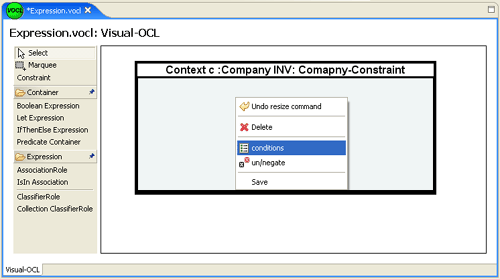| section: < previous | next > | | | |
chapter: << previous | next >> |
3.2 Working with the editor
Before presenting the creation of all other figures, we will mention general aspects of working with the VOCL-editor. This is done here, because some of them are applied on created figure, like the constraint-figure, which already was presented. Additionally, some of the points considered next can be applied to other not yet presented figures, so that working with them is only needed to explain once.
a) Moving and resizing
All figures can be moved, and some of them have variable size (like the constraint-figure). Moving simply works by chosing the "Select"-button, clicking on the figure and holding the (left) mouse-button pressed, dragging it to another location. Resizing is even as easy as moving. Select the figure, and then drag one of the highlighted points at the border of the figure by keeping the left mouse button pressed. The figure will expand into the direction the mouse is moved.
b) Saving, closing and opening a file
Now, that you have modified your diagram (by creating a constraint, moving and resizing it), some of the other necessary editors functions come into play. As you can see in the tab for that diagrams file (upper left corner of fig. 7.2), the filename is prefixed with a *, indicating that the state of the file has changed to modified. Making this modification persistent, you can save the file, either by the "File"-Menu or by clicking the toolbar-icon, and the *-symbol disappears again. Closing the file is either done by clicking the X-symbol next to the filename in the tab, or by selcting the accordant item from the "File"-Menu. Reopening of the file is also available from the "File"-Menu, or by double-clicking the filename in the Navigator-Pane of the Runtime-Workbench.
c) Undo/Redo
Another helpful editing feature is the undo/redo functionality. They are available over toolbar-buttons (see fig. 3.2.1). The left is for undo, and will undo the last editing step, whereas the right one will again redo a previously undone editing step. This can simply be tried out by moving the constraint-figure to another position. Clicking the undo button will move it back to the old location, whereas clicking redo will restore the newer position again.
 |
Fig. 3.2.1 - Undo/Redo Buttons
d) Context-Menu
Undo and redo is also available from a context-menu. This can be openend on all figures and offers actions, which are available in general and for the figure, where the context-menu was opened onto. Opening the context-menu is simply done by clicking with the right mouse-button on a figure or on the drawing area of the diagram. The context-menu opened over the constraint-figure is shown in fig. 3.2.2, which offers some other actions. Delete for example will destroy the whole figure (and all nested elements). This can also be done by selecting the figure and pressing the delete-key on the keyboard, or via the "Edit" menu. "Condition" opens a dialog to define a condition, "un- / negate" toggles the logic of the nested expression (default ist unnegated) and save will store the complete diagram, as by clicking the save button from the toolbar.
 |
Fig. 3.2.2 - Context-menu of the constraint-figure
| section: < previous | next > | | | |
chapter: << previous | next >> |
